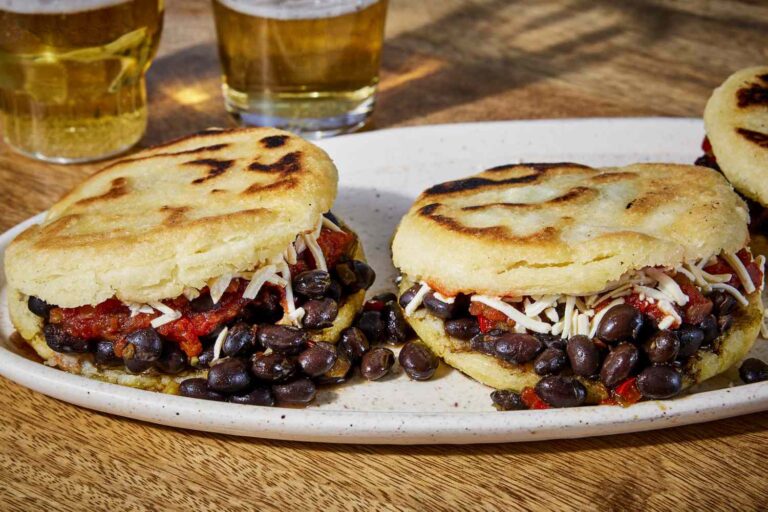Arepas
These Homemade Arepas with Reina Pepiada are an absolute game-changer! The crispy arepas are filled with a creamy, flavorful chicken and avocado mixture that’s bursting with zesty goodness. Whether you’re looking for a new dish to impress your family or just craving something deliciously different, these arepas are perfect for any meal.

Arepas are the cornbread of Colombia and Venezuela. These round, flat discs made with pre-cooked cornmeal, called “masarepa,” make an appearance at almost every meal in these two South American countries. Arepas vary from very thin, sweet, anise-flavored flatbreads, to thick, golden breads perfect for slicing in half and for stuffing with all sorts of fillings.
At their simplest, arepas are served with butter and a light cream known as “suero” or “natilla” that is similar to crème fraiche. Some are gigantic and make huge sandwiches (ham and cheese, beans and plantains, chicken and avocado salad, and shredded beef are some of the most popular fillings), while others are miniature and perfect for appetizers topped with a tomato salsa called “hogáo,” or with an avocado mixture known as guasacaca.
There are different ways to cook arepas: Some are deep-fried and produce breads with crispy exteriors and interiors the consistency of polenta, while others are cooked on a griddle and remain softer. However, most are sautéed in a little bit of oil or butter and steamed until puffy. You’ll love that the dough itself is easy to make, as long as you get the right type of cornmeal; do not substitute with masa harina (for tortillas), or with regular cornmeal, as these flours won’t work.
These semi-sweet arepas are ideal to use for either sweet or savory renditions, so top them with butter and jam for breakfast, or stuff them with your favorite ham and cheese combo for lunch.
Why You’ll Love It
- Perfect for any time of day. Arepas are great for impromptu meals, as they are assembled easily and quickly. Plus, the addition of sugar in the dough makes them slightly sweet and just right at any time of day.
- You can make these any size you want. For breakfast, make them half the size and serve them alongside eggs, sliced avocados, and beans. Or make them extra large (the size of a hamburger bun) and stuff them to the brim with your favorite filling.
Key Ingredients in Arepas
- Arepa flour (masarepa): You will find the pre-cooked cornmeal in many grocery stores and online. The two main brands are PAN and GOYA, but as long as the package confirms it’s used for making arepas, you’ll be safe. You may be able to choose between white and yellow arepa flour — don’t fuss, as they both taste and behave the same way.
- Hot water: The hot water is important because it allows the masarepa (cornmeal) to dissolve and activates the consistency that will make it malleable. It’s like instant mashed potatoes that you want to add to hot water; otherwise it will remain crispy instead of fluffy.
- Butter: The butter makes the dough a bit creamier than arepas that skip this step. It’s normally used in arepas that add sugar, which tends to toughen the corn dough.
How to Make Arepas
- Make the dough. Stir together hot water, granulated sugar, and kosher salt in a large bowl until the sugar and salt are dissolved. Stir in arepa flour, breaking up any clumps of flour, until the consistency is similar to mashed potatoes. Knead in softened butter until uniformly combined.
- Test the dough. Form a small portion into a ball and press it between the palms of your hands. If it cracks on the edges, mix more hot water into the dough, until it doesn’t crack when pressed and the edges are smooth.
- Divide the dough into portions. With moistened hands, divide into 8 portions, shaping each into a 1/2-inch-thick patty that’s about 3 1/2 inches wide.
- Cook the arepas. Heat a griddle or large nonstick frying pan over medium heat, then brush lightly with olive oil. Working in batches as needed, place as many arepas as will fit in the pan. Cook uncovered, flipping occasionally, until the outside is golden-brown in spots and the center is the consistency of polenta. Serve hot.
Helpful Tips for Making Arepas
- Don’t swap in masa harina. Masa harina, which is typically used in dishes like tortillas or tamales, is not a suitable substitution.
- If the dough cracks on the edges, it’s too dry. Add more hot water to the dough, 1 tablespoon at a time, until it doesn’t crack when pressed and the edges are smooth.